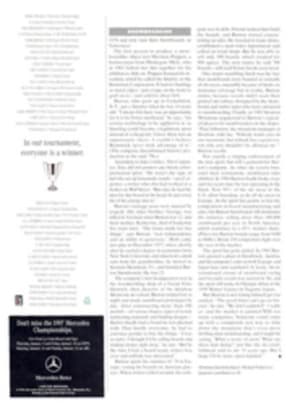
CHAIRMAN OF THE BOARD JAKE BURTON TOOK A CHILDHOOD TOY AND LAUNCHED AN INTERNATIONAL CRAZE
To find the godfather of snowboarding, you must travel to the
outskirts of Burlington, Vt., drive across a one-lane bridge and
park in front of the building that was once a Gatling gun
factory. Inside, you must wade through a display of new
snowboards, walk past a huge and eclectic array of
snowboard-making machinery, perhaps play a game on the company
pinball machine, do a two-step around a small pack of sleeping
dogs and say hello as you pass a gang of goateed and nose-ringed
professional boarders. Only then will you arrive at the office
of Jake Burton Carpenter--founder, president and chief visionary
of Burton Snowboards.
The sport of snowboarding, which entails riding surfboard-style
equipment down snow-covered mountains, is booming. Virtually
unheard of 15 years ago, snowboarding now has more than 2.3
million participants in the U.S., representing nearly 20% of the
people who visit ski resorts annually. Since 1988 the number of
snowboarders has risen 77% while the number of skiers has fallen
25%, according to the National Sporting Goods Association.
The person most responsible for transforming snowboarding into
an international craze is Jake Burton. (To avoid confusion in
business, he dropped the surname Carpenter in the early 1980s.)
The 42-year-old Burton seems to be the antithesis of a
hard-nosed businessman. He has the serene demeanor of a mature
surfer, and his 300 employees view him more as a pushover camp
counselor than as a wealthy president and founder of a
multimillion-dollar corporation. (If conditions at the nearby
Stowe ski resort are especially fine, the factory shuts down for
a staff snowboarding day.) Burton's skin is preternaturally tan,
his voice is late-night-deejay mellow, and his office attire is
ultracasual, usually jeans and a T-shirt. "I feel incredibly
uncomfortable wearing a tie," he says.
Jake and his wife, Donna, have three sons: George, 7, Taylor, 3,
and Tim, six months. When Jake runs his hands through his dark
brown hair, he seems surprised to find it short; before he
became a parent it brushed his shoulders.
"I have the best job in the world," says Burton. "I ride my
board several days a week, the company is making money, the
sport is blossoming. I'm not surprised. Snowboarding provides so
much more of a rush than skiing. Most skiers who try it never go
back."
Though Burton is often called the inventor of the snowboard, he
refuses to take credit for anything more than improving on
somebody else's idea. He settles, instead, for the label
"snowboard pioneer." The other notable pioneer is Tom Sims, who
sold his first commercial board in 1976 and now runs Sims
Snowboards, in Vancouver.
The first person to produce a snowboardlike object was Sherman
Poppen, a businessman from Muskegon, Mich., who in 1965 bolted
two skis together for his children to slide on. Poppen licensed
his invention, which he called the Snurfer, to the Brunswick
Corporation. It had no bindings or metal edges--just a rope on
the front to grab on to--and sold for about $10.
Burton, who grew up in Cedarhurst, N.Y., got a Snurfer when he
was 14 years old. "I always felt there was an opportunity for it
to be better marketed," he says, "for serious technology to be
applied to it, so Snurfing could become a legitimate sport
instead of a cheap toy. I knew there was an opportunity there. I
couldn't believe Brunswick never took advantage of it." (The
company discontinued Snurfer production in the mid-'70s.)
According to Jake's father, Tim Carpenter, Jake did not possess
any innate entrepreneurial spirit. "He wasn't the type of kid
who set up lemonade stands," says Carpenter, a writer who also
had worked as a broker on Wall Street. "But once he had the idea
for this board in his head, he put every bit of his energy into
it."
Burton's teenage years were marred by tragedy: His older
brother, George, was killed in Vietnam when Burton was 12, and
their mother, Katherine, died of leukemia five years later. "The
losses made for two things," says Burton, "real independence and
an ability to persevere." Both came into play in December 1977,
when, shortly after he earned a degree in economics from New
York University and inherited a small sum from his grandmother,
he moved to Stratton Mountain, Vt., and founded Burton
Snowboards. He was 23.
The company's first headquarters was in the woodworking shop of
a friend, Emo Henrich, then director of the Stratton Mountain
ski school. Burton tended bar at night and made snowboard
prototypes by day. After constructing more than 100 models--of
various shapes, types of wood, laminating materials and binding
designs--Burton finally had a board he was pleased with. That
hurdle overcome, he had to convince people to buy the things. "I
was so naive. I thought I'd be selling boards and making money
right away," he says. "But by the time I had a board ready,
winter was over and nobody was interested."
Burton spent the summer of '78 in Europe, testing his boards on
Austrian glaciers. When winter rolled around, his company was in
debt. Friends helped him build the boards, and Burton started
concentrating on sales. He traveled to trade shows, established
a mail-order department and called on retail shops. But he was
able to sell only 300 boards, which retailed for $88 apiece. The
next winter he sold 700 boards--still well below break-even level.
One major stumbling block was the fact that snowboards were
banned at virtually all ski areas, ostensibly because of limits
on insurance coverage but in reality, Burton claims, because
resorts didn't want their genteel ski culture disrupted by the
skateboard and surfer types who were attracted to snowboarding.
Finally, in 1983 Stratton Mountain acquiesced to Burton's
repeated pleas to let snowboarders on the slopes. "Paul
Johnston, the mountain manager at Stratton, told me, 'Nobody
wants you on our mountain, but nobody has a good reason why you
shouldn't be allowed on,'" Burton recalls.
Not exactly a ringing endorsement of the new sport, but still a
godsend for Burton's company. As other ski resorts loosened
their restrictions, snowboard sales climbed. In 1984 Burton
finally broke even, and two years later he was operating in the
black. Now 95% of the ski areas in the U.S. allow boarding, as
do all ski areas in Europe. As the sport has grown, so has the
competition in board manufacturing and sales, but Burton
Snowboards still dominates the industry, selling more than
100,000 snowboards per year in North America, which translates
to a 45% market share. (Prices for Burton boards range from $400
to $600.) About 250 competitors fight over the rest of the market.
The sport has gone global. In 1985 Burton opened a plant in
Innsbruck, Austria, and his company's sales in both Europe and
Japan have now reached U.S. levels. An international circuit of
snowboard racing and freestyle events was started in '86, and
the sport will make its Olympic debut at the 1998 Winter Games
in Nagano, Japan.
But Burton is not letting himself get too excited. "The good
times can't go on forever," he says. "We don't control the
weather, and the market is jammed with too many companies.
Someone could come up with a completely new way to slide down
the mountain that's even more thrilling than snowboarding, and I
might be saying, 'What a waste of snow! What are these kids
doing?' just like the ski establishment said to me 15 years ago.
But I hope I'll be more open-minded."
Montana-based freelancer Michael Finkel is a frequent
contributor to SI.
COLOR PHOTO: NANCIE BATTAGLIA Burton enjoys taking a boarding break from work and encourages his employees to do the same. [Jake Burton snowboarding]

